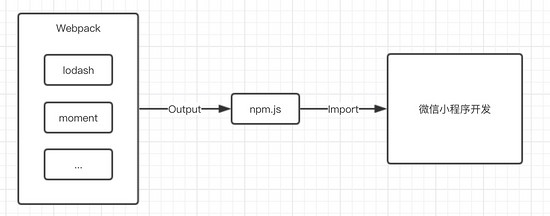原汁原味的配方:「微信小程序支持 NPM」
|
微信小程序本身不支持 npm 包的使用,目前市面上很多框架也有了相对应的解决方案。 本文旨在为那些不愿意引入第三方框架, 想在小程序环境中写原汁原味代码的人(例如我),提供一种解决问题的思路。 在现代的 Web 开发中,我们对 Webpack 已经再熟悉不过了,简单理解,它就是项目发布之前,把所有资源都打包好,然后提供一个入口文件,在入口模板中引入这个入口文件。 那么我的思路,就是利用 Webpack 把我们所有的 npm 依赖打包好,提供一个入口文件,在小程序开发中,我们通过这个入口文件,进而使用 npm 的依赖。 我们最终实现的效果应该是这样的。 例如我们小程序的首页中,需要使用到 moment pages/home/home.js:
const { moment } require('../npm/index');
const time = moment();
Webpack 打包 npm 依赖webpack 默认输出的 bundle.js ,是一个立即执行的闭包,如以下: 使用 webpack.config.js 配置:
const path = require('path');
module.exports = {
entry: './foo.js',
output: {
path: path.resolve(__dirname, 'dist'),
filename: 'bundle.js'
}
};
运行 $ webpack 生成的 bundle.js :
(function(modules){
// webpackBootstrap
})([module1, module2, module3]);
示例代码: https://github.com/JerryC8080/use-npm-in-weapp/tree/master/step1 这样的代码,显然没法达到我们要的效果。 幸好 webpack 提供了 output.libraryTarget 的配置项。 output.libraryTarget: “commonjs2”对于 output.libraryTarget: "commonjs2" 官方解释: The return value of your entry point will be assigned to the module.exports. 通过配置该属性,我们能保证 webpack 打包出来的 bundle.js ,是模块化的。 当然 output.libraryTarget 还有其他的选项值,可以查阅 官方文档 。 例如,使用 webpack.config.js 配置:
const path = require('path');
module.exports = {
entry: './foo.js',
output: {
path: path.resolve(__dirname, 'dist'),
filename: 'bundle.js',
libraryTarget: 'commonjs2',
}
};
运行 $ webpack 生成的 bundle.js :
module.exports = (function(modules){
// webpackBootstrap
})([module1, module2, module3]);
示例代码: https://github.com/JerryC8080/use-npm-in-weapp/tree/master/step2 这样,我们就可以通过 require('bundle.js') , 来使用 npm 依赖了。 在这个基础上,我们就可以打造一个使用 npm 依赖的入口。 打造 npm 入口建立入口文件:npm.js
const momennt = require('moment');
module.exports = {
momennt,
};
配置文件:webpack.config.js
const path = require('path');
module.exports = {
entry: './entry.js',
output: {
path: path.resolve(__dirname, 'npm'),
filename: 'index.js'
},
};
运行 $ webpack ,输出 ./npm/index.js 打包文件,对应的目录: . ├── entry.js ├── npm │ └── index.js └── webpack.config.js 示例代码: https://github.com/JerryC8080/use-npm-in-weapp/tree/master/step3 笨拙点的方法,你只需要把 npm/index.js 拷贝到你的项目中,就可以使用你所引入的 npm 包的内容了。 如果你的项目中使用了构建工具的话,就可以把「 webpack 打包 npm」 的这项任务加入到你的构建流程中。 我是使用 gulp 来做项目构建工作的,下面提供一种基于 gulp 的实现作为参考。 结合 Gulp 做项目工程化工程目录:
.
├── dist
│ ├── npm
│ │ └── index.js
│ └── pages
│ └── home
│ └── home.js
├── gulpfile.js
└── src
├── npm
│ └── index.js
└── pages
└── home
└── home.js
而 gulpfile 负责两件事:
gulpfile.js:
const gulp = require('gulp');
const babel = require('gulp-babel');
const del = require('del');
const runSequence = require('run-sequence');
const webpack = require('webpack');
const webpackStream = require('webpack-stream');
const webpackConfig = {
module: {
loaders: [{
test: /\.js$/,
loader: 'babel-loader',
exclude: /node_modules/,
options: {
presets: ['es2015'],
},
}],
},
output: {
filename: 'index.js',
libraryTarget: 'commonjs2',
},
plugins: [
new webpack.optimize.UglifyJsPlugin(),
],
};
// 清空 ./dist 目录
gulp.task('clean', () => del(['./dist/**']));
// 打包 npm 依赖
gulp.task('npm', () => {
gulp.src('./src/npm/*.js')
.pipe(webpackStream(webpackConfig), webpack)
.pipe(gulp.dest('./dist/npm'));
});
// 编译 JS 文件
gulp.task('scripts', () => {
gulp.src(['./src/**/*.js', '!./src/npm/*.js'])
.pipe(babel({
presets: ['stage-0', 'es2015'],
}))
.pipe(gulp.dest('./dist'));
});
// 开发模式命令
gulp.task('build', ['clean'], () => runSequence('scripts', 'npm'));
示例代码: https://github.com/JerryC8080/use-npm-in-weapp/tree/master/step4 关于控制 npm 文件代码量微信限制了项目的代码量为 2M,就算使用了分包机制,最多也是 4M 的代码量。 区区一个 moment 库的话,就算压缩过,也需要两百多 KB,这对于我们的代码量,是很不友好的。 我们需要对 npm 的引入持非常谨慎的态度,去度量每个依赖包的大小,想尽各种办法减少依赖的代码量。 譬如 moment 我们可以使用 moment-mini 来代替,后者压缩过后只需要 51KB。 而且我认为把 npm 的依赖放在一个入口文件中,会让我们可以对 npm 的依赖有一个全局的把握。 |




